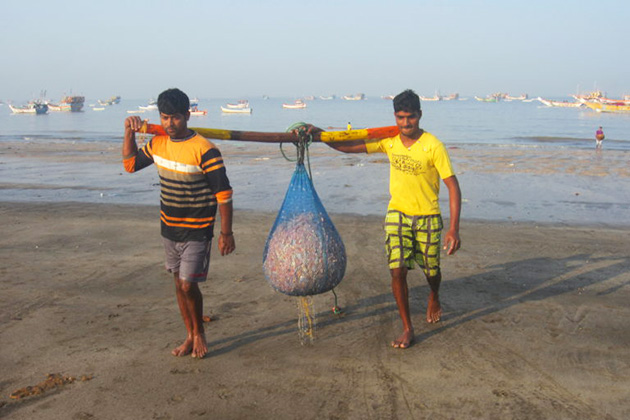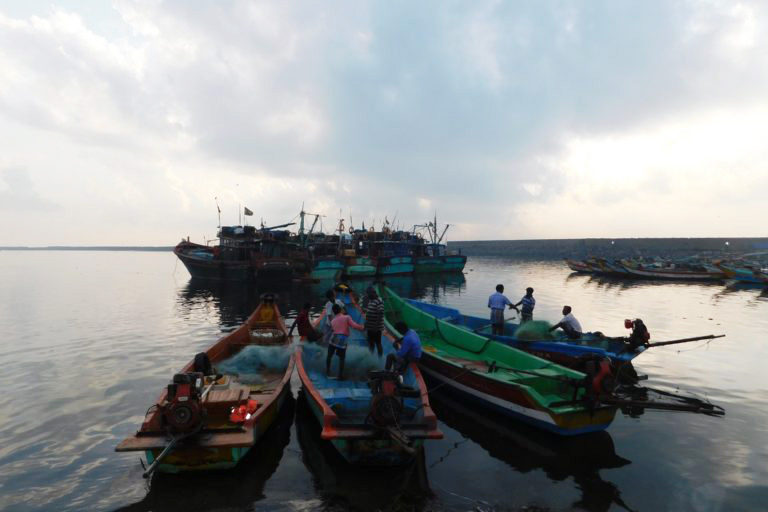Low fish catch along India’s western coast hints at impacts of climate change

- Maharashtra witnessed lowest fish catch in 45 years in 2019. Fishers have also reported a 50% decline in their annual fish catch, attributing recurring cyclones for reducing their fishing window.
- Nationally, the estimate of marine fish landings in India shows a marginal increase of about 73,770 tonnes (2.1%) for 2019
- Fish migrate from warm waters to cool waters, a phenomenon that has already begun as the Indian ocean is warming up is one of the reasons for lower fish catch.
- The marine algae that is the base of aquatic food web has been disappearing in the western Indian Ocean owing to rising sea temperatures.
Fish catch from the western coast of India has declined, according to the Marine Fish Landings Report 2019 by the Central Marine Fisheries Research Institute (CMFRI). Climate scientists attribute this drop to the increasing pollution, global warming and a decrease in phytoplankton population.
In 2019, Maharashtra, on India’s west coast, witnessed the lowest annual catch in 45 years, reveals an estimate from previous CMFRI reports, with a steep decline in all the fish species being caught.
The total estimated fish landings (fish catch that arrives at the ports) in the state stood at 201,000 (2.01 lakh) tonnes in 2019 against 295,000 (2.95 lakh) tonnes in 2018, marking a 32% decrease, the latest report, released last month, added.
Most of the fish catch came from Mumbai city district, followed by Raigad and Ratnagiri. Apart from the non-penaeid prawns, every other fish species showed decreased landings in comparison to 2018.
K.V. Akhilesh, a scientist with CMFRI Mumbai, stated that extreme weather patterns, extended rainy season and continuous large-volume exploitation of young fish/juveniles are the major reasons for low catch. These extreme weather events are the result of climate change and are likely to increase in the coming years, he said.

The report by the Fishery Resources Assessment Division of ICAR-CMFRI used data collected from all the 1,265 marine fish landing centres along the Indian coast through the stratified multistage random sampling design and estimates of species wise, fishing zone wise and gear-wise landings were made for all the maritime states.
Decline in phytoplanktons
Global warming has given rise to a host of problems such as a decline in phytoplankton population and migration of fish, which affects the fishing industry, indicate experts.
Roxy Mathew Koll, a scientist with the Indian Institute of Tropical Meteorology, Pune, told Mongabay-India that the decline in the number of fishing days on the western coast was owing to extreme weather events like heavy rains, weather in the Arabian Sea and overfishing, while highlighting that the weather issues are a consequence of climate change.
The ocean surface warming in the Indian Ocean during the past century is up by 1.2 degrees Celsius, compared with a global surface warming of up to 0.8 degrees Celsius during the same period, according to a study by Koll.
Koll explained that fish migrate depending on the temperature and they usually migrate from the tropical waters (warm) to the north (cool), and that trend has already been observed in the Indian waters.
Another study led by Koll showed a significant decline in the marine phytoplankton (microscopic marine algae which are food for whales, shrimp and jellyfish) in the Indian Ocean. Phytoplanktons absorb the solar radiation and modulate the upper ocean heat flux, thereby influencing climate processes, according to the study.
The study indicated that the marine phytoplankton population has decreased by 20% in the last six decades and it has declined by 30% in the western Indian Ocean during the last 16 years because of rapid warming. A decline in the marine phytoplankton population can affect the marine food chain, turning a biologically productive region into an ecological desert and impact the food security in the countries bordering the Indian Ocean, the study noted.
Almost 90% of the extra heat owing to increased greenhouse gases has been absorbed by the oceans, and it is taking a huge toll on the marine ecosystem.
West coast shows declining trend, India shows marginal increase in fish catch
India is the second-largest producer of fish in the world, contributing to 5.43% of global fish production. Generally, about 60-75% of India’s marine catch comes from the country’s west coast. Apart from nutritional security, Indian fisheries also provide livelihood support to over 14 million (1.4 crores) people.
Not just Maharashtra, the entire western coast has shown a declining trend in annual fish catch. Goa, Kerala and Gujarat witnessed a drop in fish landings of 44.4%, 15.4% and 4% respectively. Species like the Indian mackerel (Rastrelliger kanagurta) and the Indian oil sardine (Sardinella longiceps) were among the species which saw the highest drop in 2019.
However, nationally, the estimate of marine fish landings in India shows a marginal increase of about 73,770 tonnes (2.1%) for 2019, an estimate of 3.56 million tonnes in 2019, compared to 3.49 million tonnes in 2018. The upwards trend here was witnessed due to increased fish landings in the eastern coast, with Tamil Nadu taking up the top spot in terms of fish landings.

In 2019, India faced six severe cyclones — Fani in April, Vayu in June, Hika in September, Kyarr in October, Maha in October-November and Bulbul in October-November — which adversely affected the fishing calendar days, especially in the west coast, the CMFRI report mentioned.
Ganesh Nakhawa, a member of the Karanja Fishing Cooperative Society in Raigad, told Mongabay-India that the fishers are stressed as they suffered a decline of almost 50% in their annual fish catch and attributed this decline to global warming and climate change.
“Last year, the western coast witnessed many cyclones due to which the fishing days were less and the cyclones are increasing from the last three years,” he added.
The El Niño concern
In 2019, the Intergovernmental Panel on Climate Change released a report where it observed that climate change was the reason behind increased precipitation, winds and extreme sea-level events associated with some tropical cyclones.
The report also listed that the average intensity of tropical cyclones is related to the 2ºC increase in global temperature rise and rising mean sea levels will contribute to higher extreme sea levels associated with tropical cyclones. Satellite observations in the report revealed that marine heat-waves (short period of abnormally high temperatures in a sea or ocean) doubled in frequency between 1982 and 2016 and have become more intense, and extreme phenomenon like El Niño and La Niña are projected to likely increase in frequency across the globe, mainly in the Indian Ocean.
According to the CMFRI report, in addition to the declining trend of common resources that were once prevalent in the western coast, unusual formations of frequent cyclones occurred in the Arabian Sea was one of the major reasons for the reduced landings and caused a 36% drop in fishing days.
Koll mentioned that the Indian Ocean is warming rapidly due to which these severe cyclones are projected to increase and the only way to deal from these cyclones is to reduce carbon emissions.
This article first appeared on Mongabay.







